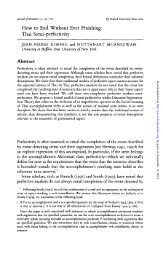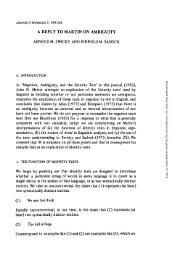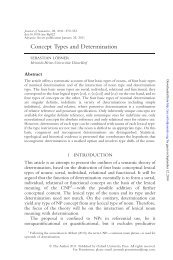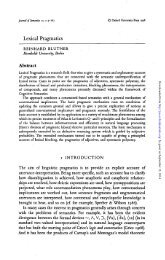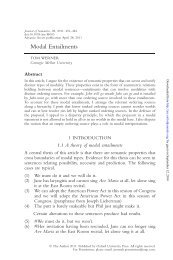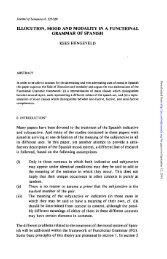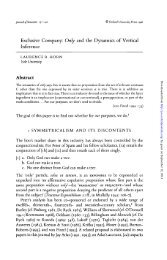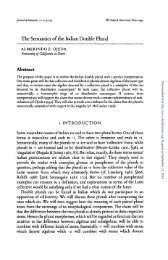Aspectual Coercion and Logical Polysemy - Journal of Semantics
Aspectual Coercion and Logical Polysemy - Journal of Semantics
Aspectual Coercion and Logical Polysemy - Journal of Semantics
Create successful ePaper yourself
Turn your PDF publications into a flip-book with our unique Google optimized e-Paper software.
148 <strong>Aspectual</strong> <strong>Coercion</strong> <strong>and</strong> <strong>Logical</strong> <strong>Polysemy</strong><br />
about' (the AGENTTVE role) <strong>of</strong> the resulting state <strong>of</strong> y (the FORMAL role), where<br />
this state, P(e 2 , y) did not hold before. 16 This representation is underspecified,<br />
however, in that there is no event head in the structure. In fact, it is this<br />
semantic underspecification which gives riseto the polysemy exhibited by these<br />
predicates. By heading (or focusing) the initial event, associated with AGENTIVE,<br />
a causative template arises. By heading the finalevent, however, associated with<br />
FORMAL, an unaccusative structure arises (cf. Pustejovsky & Busa 1994 for<br />
details).<br />
A similar analysis holds for verbs such as commencer, which exhibit a logical<br />
polysemy between control <strong>and</strong> raising senses. We will view commencer as the<br />
lexical version <strong>of</strong> an unaccusative marker, but for events rather than for<br />
entities. 17 Underlying the lexical representation for verbs that exhibit control<br />
<strong>and</strong> raising behavior is a deep or underlying causative. The alternation<br />
displayed above is licensed by the headless nature <strong>of</strong> the event structure<br />
representation <strong>of</strong> the predicate commencer. Whether it surfaces as a raising verb<br />
or a transitive control verb will be determined by which subevent is headed. In<br />
this view, then, the core lexical representation for commencer is given below,<br />
where the variables P <strong>and</strong> R are unspecified predicates, <strong>and</strong> there is no headed<br />
event. 18<br />
(36) XxXPXe 2 Xe^ 3 R 3 P [commencer: ES — e x < occ e 2 A FORMAL = [P(e 2 , x)]<br />
A AGENTTVE — [R(e,, X, e 2 )]]<br />
If the initial event is headed, a control structure results. If, however, the final<br />
event is headed, a raising construction results. In the next section, we<br />
demonstrate how this underspecified semantic representation is responsible for<br />
both control <strong>and</strong> raising constructions for aspectual predicates such as<br />
commencer, <strong>and</strong> the constraints on coercion in these constructions.<br />
6 THE SEMANTICS OF ASPECTUAL COERCION<br />
Let us now examine in more detail the semantics <strong>of</strong> aspectual raising <strong>and</strong><br />
control constructions. We assume that there are two typings for commencer, as<br />
shown above in (28), <strong>and</strong> that they are logically related senses by virtue <strong>of</strong> the<br />
semantic representation given above in (36).<br />
The phenomenon <strong>of</strong> coercion described above is similar, in some respects, to<br />
subtyping polymorphism as encountered in examples such as (37) below. 19<br />
(37) a. Mary drives a Honda to work<br />
b. Tom read the Tractatus on holiday.<br />
Assuming that the internal type selected by the verb drive in sentence (37a) is<br />
vehicle, as illustrated in the typing for the verb:<br />
Downloaded from http://jos.oxfordjournals.org/ by guest on September 12, 2014



